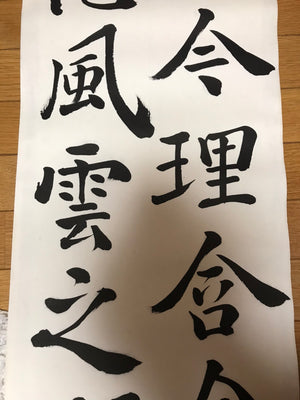Calligraphy is one of the most beloved and difficult practices in modern Japan. Having its roots in China, the earliest evidence of pictographs goes back to 2700 BCE. Scrolls first appeared around 7th century, and give us an idea about how people used to write.
Initially all characters, or Kanji, were copied from China. However the Japanese quickly developed their own writing systems (hiragana and katakana), resulting in a kind of calligraphy found only in Japan.


The main purpose of calligraphy is to perfectly execute the strokes of a character. However every time we do that is different due to the environment outside and our state inside. Thus the Japanese believe that calligraphy imprints the mental and emotional states of the artist on the canvas.
When a calligrapher prepares to write a few characters, he or she can only use wet ink and a brush, thus having only one chance to execute the moves. No corrections are possible. Confidence and focus can be seen in the result.
Being confident, present, focused and able to execute in a fluid manner are the main lessons of calligraphy.
It is not a surprise that such a practice is closely connected to Zen Buddhism. Although in essence calligraphy only involves writing with a brush on paper, it is considered an art. This art is believed to forge good principles in young people's characters.
It is almost a form of meditation or, at the very least, associated with it. Traditionally displaying calligraphy was a vital part of the Japanese tea ceremony.
How can you practice? Get yourself black ink, a brush and a lot of paper. Or just a brush pen! Choose a character you want to practice, and go for it. Then look at your work while enjoying a nice cup of tea (or coffee).

All the pictures displayed are the work of Miss Ohashi, a salesperson in Suwada Open Factory, Japan.

